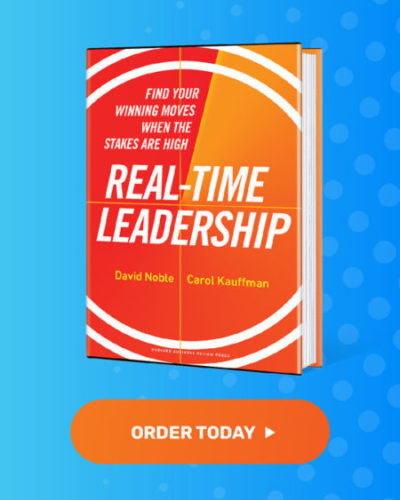Guest post by Carol Kauffman
How do we become the best leader we can be? How do we help others to rise to their best performance? The answer is in what we call Three-Dimensional Leadership. For any challenge we need to be able to address:
- What you need to do
- Who you need to be
- How you need to relate
These are inseparable dimensions. We know leaders who excel at one of these. Perhaps they excel at meeting all the numbers to create growth but overlook leading with vulnerability to create psychological safety. In contrast, there are some who are nurturant but cannot hold others accountable.
Having all three makes for great leadership that is human- centered as well as business- centered – leading to great performance with high-engagement and meaning.
The first step is becoming a Real-Time Leader.

What are the key choices available to us? There are thousands of moments in a day, and many windows of opportunity. How do we make the most of these moments?
My co-author David Noble and I have drawn from business and military strategy, multiple theories of psychology and in-depth analysis of our coaching work to deeply understand the steps to achieve real-time leadership.
We call this new idea the MOVE framework. Each step helps you find, open, and use that space between what is thrown at you (stimulus) and what you do with it (response).
The following gives you an overview of the MOVE framework, followed by a deep-dive into M: Be Mindfully Alert to the three dimensions of leadership.
- M: Be Mindfully Alert. Mindful Alertness in high-stakes situations means being exquisitely aware of what is needed from you at any moment. Mindful, is calm awareness. Alert is being precise about and flexible with where you put your attention, like an elite athlete in a fast-paced competition.
- O: Options Generator. We know about Will-Power, but Way-Power is equally important and is the bedrock of agility and resilience. You want at least four pathways forward and four ways to win and make either whip-fast or slow, thoughtful decisions in real time.
- V: Validate Your Vantage Point. Check your take on reality and choose the best point of view. It’s crucial to understand what factors can distort your view and cause you to over or underestimate risks and opportunities.
- E: Engage and Effect Change. Do this first as an individual, then at scale with an ability to send out the right leadership signals, hear the echoes, and iterate.
The journey begins with the capacity to make space to truly see, to be aware and alert to the challenges we face.
Mindfully Alert

What is needed requires overcoming your reflexes, habits that are hard wired because they’ve worked so well. But now, you need a new playbook.. Can you transcend your default modes and expand beyond your old normal, to your new optimal.
Let’s revisit our three questions to unlock becoming a 3-D leader.
Dimension One: What do you need to do?
What we need to do in order to meet the demands we face.
These can include specific high-stakes priorities pulling off a merger, driving organizational change, making a successful decision, dealing with a conflict, or getting promoted. But there are many smaller moments that add up in powerful ways. Perhaps someone on your team does a subpar job on an important project.
This is the moment. Stop and ask yourself: What do I really need to achieve?
Research shows that pausing and naming what you need to do in the moment increases your capacity to do it. Creating a moment of space allows you to make a better choice.
You may think your “goal” is to have a decision at the end of a meeting. However, what if it really is to have the team feel aligned and engaged. Or, when team member delivers a sub-optimal project, ask yourself, What really needs to happen now? Your default may be to go into a tough or developmental conversation. But can you move beyond that to be mindfully alert?
What if the optimal outcome is uncovering a larger systems issue that led to the suboptimal performance?
Dimension two: Who do you want to be?
This split-second question that can change your life
As a leader, you are under the kind of pressure that would crush others. But how much time have you invested in developing the inner resources that help you stay resilient under the pressure? The core to making space is developing emotional regulation. Then, you can overcome the pull of reflexes that have the power to hijack your ability to choose.
Knowing and living your core purpose can act as a buffer between what is thrown at you and what you do with it.
To get started, try asking yourself, “Who do I want to be?” 50 times today. Before, during or after any interaction. When someone cuts you off, and you begin to react, ask yourself: Who do I want to be, right now? As you react – are you being the person you want to be? Leadership is something you “emanate.” What do you want to project?
Dimension three: How do you need to relate?
Forget the Golden Rule, Go Platinum
We have learned that we should treat others as we would like to be treated. True, but it’s a lower bar than you think. The Platinum Rule is treat others as they would like to be treated.
If you can pause to look at the world of the other person, this type of reflection can help you unlock who you truly want to be in a given moment.
The third question is the interpersonal dimension: do you know how to create relationships that empower others and unlock optimal well-being and performance in them? Notice our question is how to lead in the way others need, not how to lead in the way that you’d personally prefer. The Golden Rule is too low a bar. Instead, the Platinum Rule ensures everyone has access to a working relationship that sings in harmony.
How do we become the best leaders we can be?
Simply pausing to ask yourself these three questions before taking action is crucial to formulating an optimal approach and becoming a human-centered leader in real-time. Yes, we need to meet the external goals of the organization. But to do so effectively, we need to make space and pause, even if just for a moment.
By naming and practicing who you want to be, you are training your brain to be less reactionary through micro-behaviors that are essential for human-centered leadership at all levels.
When you are able to choose who you want to be in a high-stakes situation and lead from your strengths –that’s being human-centered AND leading in real-time.

Follow her on LinkedIn!


